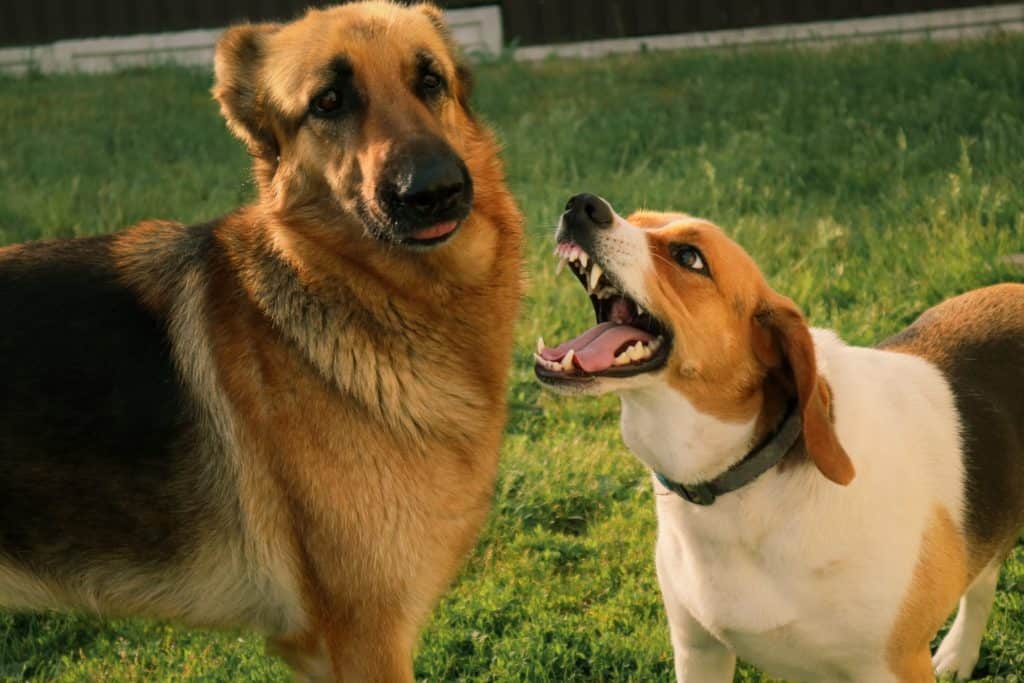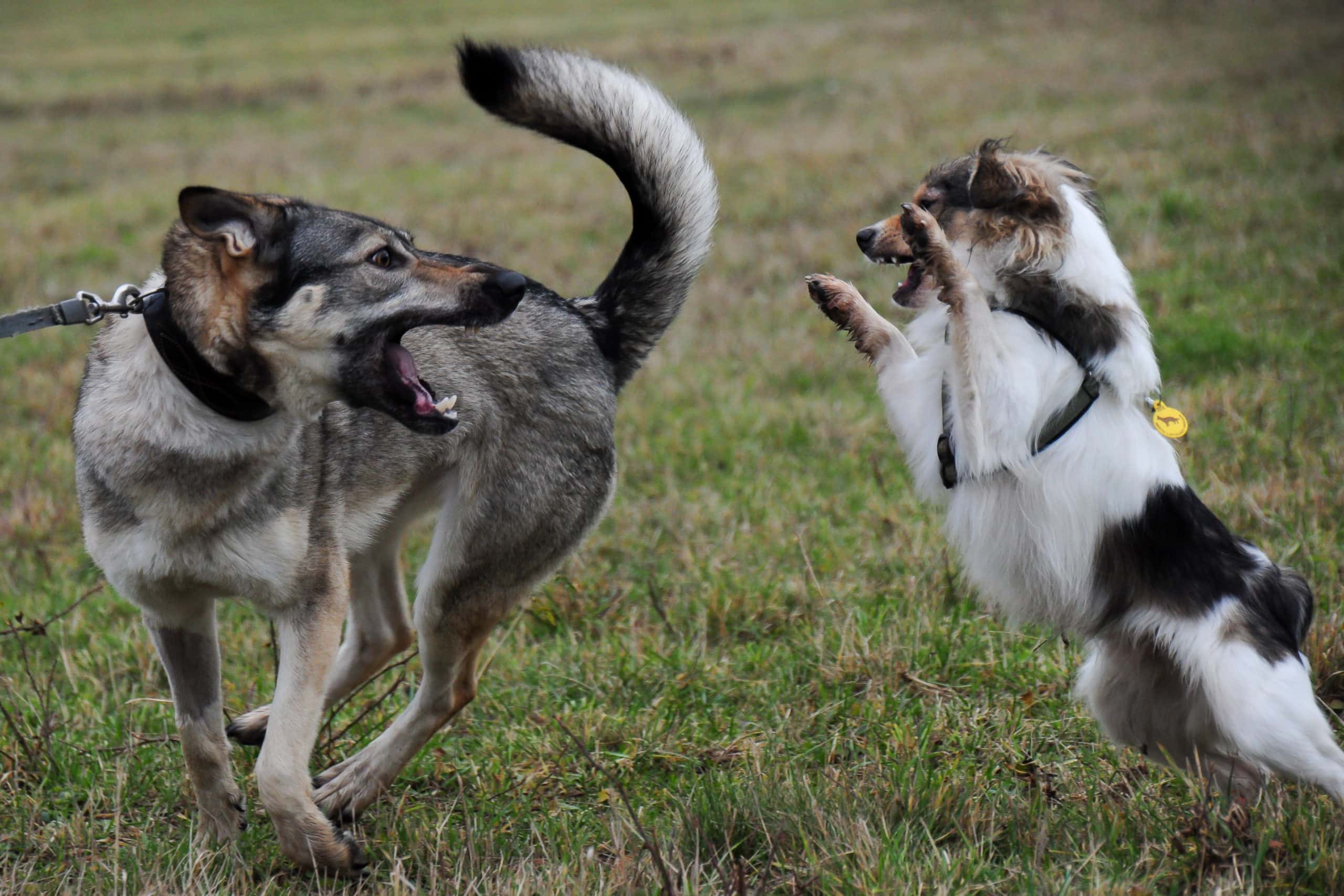At Greenside Canine, we are advocates of responsible dog ownership. Our team always wants to encourage owners to socialize their dogs around other pups. Ensuring that dogs can behave appropriately in different environments – including with unfamiliar dogs – is vital to building a well-rounded, stable dog.
If you’ve ever taken your dog to a dog park, you have likely noticed there is always that one dog. You know the one. He’s a little rowdier than other dogs at the park. His energy is up a notch. He won’t stop bothering every other dog in the enclosure, constantly chasing, nipping and displaying all other kinds of potentially bothersome behavior. And this behavior is usually accompanied by sideline commentary from the dog’s owner.
“Oh, he’s so playful,” they exclaim. “He just loves being around other dogs. This is so good for him!”
However, in reality, there is a fine line between playful behavior and aggressive behavior. Misdiagnosing aggressive behavior as a dog simply “being playful” is surprisingly common, and it can have detrimental consequences for the dog, its owner, and other dogs who come into contact with the dog. More than anything else, it could be dangerous. Being able to identify aggression in your dog – and distinguishing it from play – is pivotal, and can help to manage any behavioral issues before they escalate.
In this article, we’re going to explore common signs of playful and aggressive behavior in dogs, and why taking the time to correctly identify your dog’s behavior can help both you and your dog.
Common signs of playful behavior
Looking at your dog’s body language can help you understand whether they are acting in a playful or aggressive manner. It is important to note that these behaviors can be seen in isolation, or together. Instances of playful behavior are typically:
- Relaxed posture
- Frequent blinking
- Relaxed ears
- Wagging tail
- Play-bowing
- Rolling on their back
These behaviors will typically indicate that your dog is comfortable with the situation and is engaging in healthy, mutually beneficial play.
Common signs of aggressive behavior
When play progresses to aggression, there are normally a few telltale signs. The difficulty lies in trying to distinguish the two – which is why so many dog owners struggle and get play and aggression mixed up. Some usual signs of aggression are:
- Panting
- High, stiff tail
- Exposed teeth
- Frequent yawning
- Snarling/growing
- Low, deep barks
Of course, dogs can display these behaviors for any number of other reasons, such as anxiety or stress. This adds further complexity to sorting playful behavior from aggression.
Dog aggression - why watching how both dogs interact is pivotal
When trying to determine if a dog’s behavior is aggressive towards another dog, we can often infer some clues from watching how they respond to one another.
In a play situation, both dogs will have the opportunity to initiate some form of behavior, such as rolling on their back or encouraging the other dog to chase them. The behavior is typically returned in kind, and this may last for four to five minutes before the dogs become bored of playing with one another.
However, in scenarios which may involve aggression, the behavior is not reciprocated – and the dog initiating this behavior simply won’t let up. If Dog A is aggressive towards Dog B, Dog B isn’t going to simply sit there and act like everything is a fun game. In fact, the opposite will occur. if Dog A is persistent and refuses to leave Dog B alone – through constantly exhibiting behaviors that are tantamount to bullying – Dog B has a couple of choices. It can either try to fight back with a response of its own, or it can create separation. You may have heard this referred to as the ‘fight or flight’ principle.
One final point to note is that, as dogs play together for longer, there is the potential for rough housing and play biting to escalate into something more serious. This is why it is crucial to remain vigilant and watch how your dog behaves around other pups – particularly if they have only just met that dog.

How to manage aggressive behavior
While ensuring your dog is well-socialized and has a solid obedience foundation should offer you more control as an owner, the harsh reality is that some dogs unfortunately develop aggression despite their owner’s best intentions.
The key to analyzing your dog’s aggressive behavior requires you to take a step back and understand the trigger for the behavior in the first place. What happens when your dog displays aggressive behavior? What is the context? Who is around (other dogs or family members)? What resources are at stake? What caused your dog to react in that manner?
Armed with that information, you can come up with a management strategy to mitigate the aggressive behavior. Management strategies will vary depending on the precise nature of the aggression, but it could involve removal of resources in group settings (example: removing the constant availability of dog toys in the home), confinement (timeouts in crates, or separation from others), or the use of muzzles when around other dogs.
Positive reinforcement and redirection can be used to try and establish better habits, and constant supervision to ensure the dog does not become triggered by the stimuli is essential. In a nutshell, the best protection strategy is attempting to ensure that you remain calm, stay prepared, and are always watchful of your dog in any situation that could escalate to aggression.
Other types of aggression
In addition to outright dog aggression, there are other types of aggression. This behavior is typically triggered by an intrinsic response from the dog to protect themselves and/or their resources. Other types of aggression include:
- Territorial aggression – When a dog is protective over its space and surroundings (such as their backyard).
- Fear aggression – When a dog responds aggressively because they are scared, anxious or trapped in a specific situation.
- Possessive aggression – When a dog becomes aggressive due to a belief that a resource (toy, food, or person) will be taken from them.
- Barrier aggression – When a dog responds in an aggressive manner due to a restriction or barrier placed upon them (such as when confined to a crate, or in a backyard with a fence that prevents them from escaping).
You may have seen your dog display behaviors which span one or more of the categories above.
What to do if you are concerned about your dog’s behavior
When it comes to canine behavior – and particularly when we think about aggression, and the potential damage that dogs can do – it is best to approach the situation with an abundance of caution and a safety-first mentality.
Identifying whether behavior is playful, aggressive or somewhere between the two is often a task best carried out by an expert, like a professional dog trainer or behaviorist. The ideal scenario would see the trainer watch the dog (either in-person, or through video footage) and make a determination on what is actually occurring in these potentially aggressive situations. From there, the trainer can deliver their assessment and coach you on the next steps.
At Greenside Canine Training, our team of professional trainers is here to help you! If you have any concerns about your dog’s behavior, we would love to speak with you and learn more about how we can help. Aggression – even if it is only potential aggression – can be hugely stressful, and it is reassuring to know that you have experts in your corner. Contact us today for more information.

